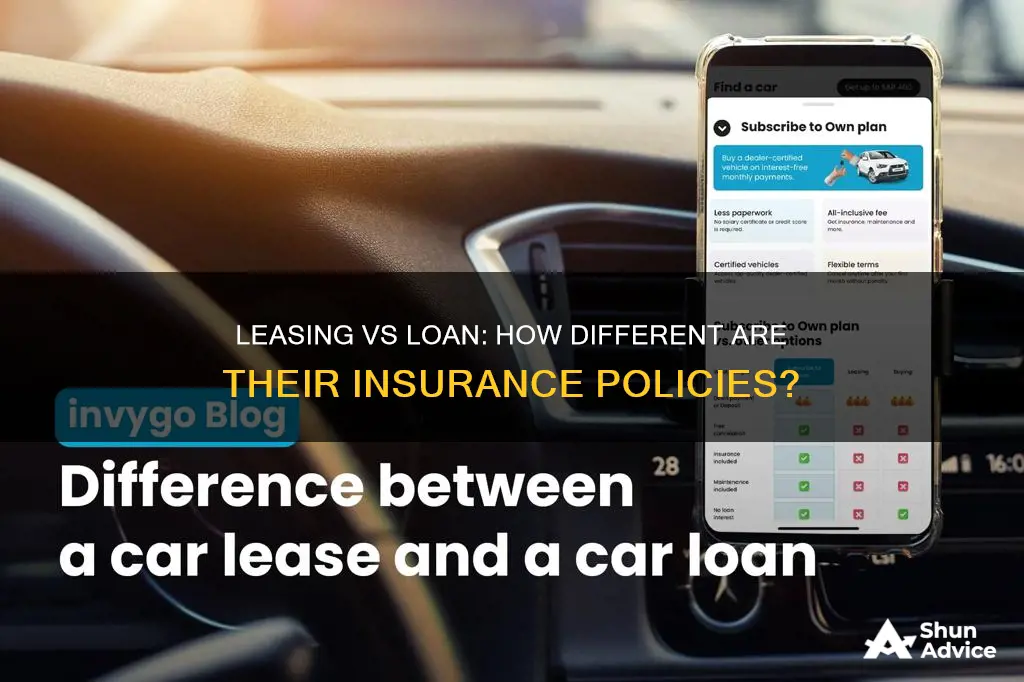
Whether you lease or take out a loan to buy a car, you will need to have the minimum required coverage to drive legally in your state. However, there are some differences in the insurance requirements and costs between leasing and buying a car. This paragraph will explore these differences and help you understand how insurance may differ depending on whether you lease or take out a loan for a vehicle.
What You'll Learn
- Leasing a car means you don't own it, so you must keep it in excellent condition
- Lease contracts include an annual mileage allotment, usually 12,000-15,000 miles
- Leased cars are generally more expensive to insure than financed and owned vehicles
- Gap insurance covers the difference between the car's value and the loan balance
- When you buy a car with a loan, you can drive as many miles as you like without restriction?

Leasing a car means you don't own it, so you must keep it in excellent condition
When you lease a car, you don't own it, and you must return it to the dealer at the end of the lease term. This means that you have to keep it in excellent condition to avoid fees for any dings, scratches, or stains when the lease ends. Most leases are for three years or less, and leasing companies will often restrict your mileage, typically to between 12,000 and 15,000 miles per year, with excess mileage costing an average of between $0.10 to $0.25 per mile. You will also be required to carry full coverage on your vehicle, including collision and comprehensive coverage, to protect the vehicle. This means that insurance for a leased car is generally more expensive than for a financed or owned vehicle.
Leasing companies will also usually require you to list them on your auto insurance policy and purchase both collision and comprehensive coverage in addition to your state minimums. Collision coverage will cover damage to your vehicle after an accident, regardless of fault, while comprehensive coverage includes non-accident damage or loss, such as theft, vandalism, weather damage, or fire. These policies are mandated by the lender or lessor to protect the vehicle, as otherwise, they would face a total loss if you were in an accident.
Gap insurance is another type of coverage that you may want to consider when leasing a car. It is designed to protect car owners, in this case, the leasing company, if their vehicle is totaled or stolen. It covers the difference between the actual value of the vehicle and the outstanding balance on the car loan. Some leasing companies include this in your leasing payments, while others will require you to purchase it separately.
It is important to carefully review your leasing contract, as there may be other conditions you must follow to avoid fees at the end of the lease term.
IMF's Dollar-Denominated Loans: How Do They Work?
You may want to see also

Lease contracts include an annual mileage allotment, usually 12,000-15,000 miles
Lease contracts typically include an annual mileage allotment, usually between 12,000 and 15,000 miles. However, this can vary, with some leases offering as few as 8,000 miles per year, while others offer high-mileage leases of 25,000 miles or more annually. It's important to carefully review the mileage terms of your lease contract, as going over the allotted mileage can result in significant fees. For example, exceeding the mileage limit by 1,000 miles per year at a rate of $0.15 per extra mile would result in a $150 annual fee. If your rate is $0.25 per mile, that fee increases to $250. These fees can add up quickly, so it's important to choose a mileage cap that aligns with your driving habits.
If you anticipate driving more than the standard annual mileage allotment, you may want to consider a high-mileage lease. While this option typically comes with a higher monthly payment, it can be more cost-effective than paying extra fees for exceeding your mileage limit. Additionally, some leasing companies may offer flexibility in negotiating the number of miles included in your lease, although this may come at an additional cost.
It's worth noting that, regardless of whether you lease or finance your vehicle, you must adhere to the coverage requirements of your leasing company or lender. They usually require you to list them on your auto insurance policy and purchase both collision and comprehensive coverage in addition to your state's minimum requirements. This ensures that they are protected in the event of an accident, as they remain the owners of the vehicle until you purchase it outright.
When deciding between leasing and buying, it's important to consider your personal preferences and financial situation. While lease payments tend to be lower than loan payments, you won't own the vehicle at the end of the lease term. Additionally, leasing companies may charge fees for damage to the vehicle during the leasing period, and you'll need to maintain the car in excellent condition. On the other hand, buying a car with an auto loan allows you to drive as many miles as you like without restriction and own the vehicle outright once the loan is paid off.
Hospice Equipment: What's Available on Loan?
You may want to see also

Leased cars are generally more expensive to insure than financed and owned vehicles
When it comes to car insurance, there are a few key differences between leasing and financing a car. While leasing a car can often result in lower monthly payments compared to a car loan, the insurance requirements for a leased vehicle can be more extensive and costly.
Leasing firms typically impose higher coverage limits and require additional policies, such as collision and comprehensive coverage, to protect the vehicle. These policies cover damage to the vehicle, whether from an accident or non-accident causes like theft or vandalism. Since the leasing company retains ownership of the vehicle, they mandate these policies to safeguard their asset. As a result, lease payments may include gap insurance, which covers the difference between the vehicle's value and the outstanding loan balance if the car is totalled or stolen.
On the other hand, when you finance a car, you are working towards owning the vehicle outright once the loan is repaid. While full coverage is initially required, you have the flexibility to adjust your coverage after the loan is paid off. At that point, you can opt for minimal liability insurance or drop comprehensive and collision coverage to save money.
It's worth noting that insurance companies typically do not differentiate between leasing and purchasing a car when determining insurance rates. Factors such as your driving record, vehicle type, and safety as a driver play a more significant role in determining insurance costs.
In summary, while leasing a car may offer lower monthly payments, the insurance requirements can make it more expensive overall compared to financing and owning a vehicle. The higher insurance costs associated with leased cars are a trade-off for the lower lease payments, allowing you to drive a newer car without the long-term financial commitment of a loan.
Loan Activity and M2 Growth: Exploring the Connection
You may want to see also

Gap insurance covers the difference between the car's value and the loan balance
Whether you lease or take out a loan to buy a car, you will need to have the minimum required coverage to drive legally in your state. However, there are some differences between leasing and buying a car that you should be aware of. When you lease a car, you will be making monthly payments for the duration of your lease, and you will have to return the car to the dealer at the end of the lease. On the other hand, if you take out a loan to buy a car, you will eventually pay off the loan and own the car outright.
One important consideration when leasing or buying a car is whether to purchase gap insurance. Gap insurance covers the difference between the car's value and the loan balance in the event of a total loss or theft of the vehicle. This type of insurance is especially important if you owe more on your loan or lease than the car is worth. For example, if you owe $25,000 on your loan but your car is only worth $20,000, gap insurance will cover the $5,000 gap, minus your deductible.
Gap insurance is optional, but it may be required by some lenders or leasing companies. It is important to check the terms of your lease or loan to see if it includes gap insurance before purchasing a separate policy. Gap insurance can provide valuable financial protection in the event of a total loss or theft of your vehicle. Without gap insurance, you may be responsible for paying off the remaining loan or lease balance if the car's value is less than the outstanding balance.
In addition to gap insurance, you may also need to purchase collision and comprehensive coverage to meet the requirements of your lease or loan. Collision coverage protects your vehicle in the event of an accident, regardless of fault. Comprehensive coverage protects your vehicle from non-accident damage or loss, such as theft, vandalism, weather damage, or fire. These types of coverage are typically required by lenders or leasing companies to protect their investment in the vehicle.
Overall, whether you lease or take out a loan to buy a car, it is important to carefully consider your insurance options and choose the coverage that best meets your needs and requirements.
Loan Deferment: Does Time Impact Your Options?
You may want to see also

When you buy a car with a loan, you can drive as many miles as you like without restriction
When it comes to car insurance, there are a few differences between leasing and buying a car with a loan. Firstly, leasing a car often comes with certain restrictions, such as mileage limits, that can impact your overall costs. Most leasing companies restrict mileage to around 12,000 miles per year, and you may have to pay additional fees for exceeding this limit. On the other hand, when you buy a car with a loan, you typically own the vehicle outright once the loan is repaid, and you are free to drive as many miles as you like without any mileage restrictions.
Leasing a car usually involves making lower monthly payments compared to a car loan. However, these payments continue for the duration of the lease, which is typically for a set term, such as three years. At the end of the lease, you return the car to the dealer. In contrast, with a car loan, your monthly payments may be higher, but once the loan is repaid, you own the vehicle, and there are no further payments required. This means that while the monthly cost of leasing may be lower, you will ultimately pay more over time for a leased car compared to buying a car with a loan.
It's important to note that regardless of whether you lease or buy a car with a loan, you are required to have the minimum auto insurance coverage mandated by your state. Additionally, both leasing companies and lenders will often require you to list them on your auto insurance policy and purchase both collision and comprehensive coverage. Collision coverage insures your vehicle against damage in an accident, regardless of fault, while comprehensive coverage insures against non-accident damage or loss, such as theft, vandalism, or fire.
While leasing a car, you are typically required to maintain full coverage for the duration of the lease. However, once you own a car after repaying a loan, you have the option to adjust your coverage. You can choose to drop the comprehensive and collision coverage and save money, especially if your car has depreciated significantly. Additionally, leasing companies may include gap insurance in your lease payments, which covers the difference between the actual value of the vehicle and the outstanding balance on the lease if the car is totalled or stolen. When buying a car with a loan, you may want to consider purchasing gap insurance separately to protect yourself financially in such situations.
Helco Modification: Does ICCU Provide Loan Options?
You may want to see also
Frequently asked questions
There is no significant difference in insurance rates when leasing or buying a car. Insurance companies are primarily concerned with your driving record and the type of vehicle you are insuring. However, leasing firms may impose higher coverage limits and require additional policies, making insurance for leased cars generally more expensive.
When leasing a car, you are required to carry full coverage on your vehicle, including collision and comprehensive coverage in addition to your state's minimum requirements. Leasing companies will also require you to list them on your auto insurance policy.
When taking out a loan to purchase a vehicle, lenders will require you to carry full coverage, including collision and comprehensive coverage. Once you have paid off the loan, you can adjust your coverage accordingly and drop the full coverage in favour of minimal liability insurance.







